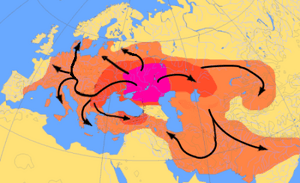Kurgan hypothesis facts for kids
The Kurgan model is a big idea about where the Indo-European people came from and how their ancient language, called Proto-Indo-European, spread across Europe and Asia. It's like a detective story that uses clues from old digging sites (archaeology) and how languages changed over time (linguistics). This model helps us understand the history of these people and their culture as they moved to new places.
Contents
What is the Kurgan Model?
The Kurgan model suggests that the first Indo-European speakers lived in the steppes (large grasslands) of Eastern Europe and Central Asia. These people were often nomadic, meaning they moved around a lot. They were known for burying their dead in special mounds called "kurgans." These kurgans are like ancient burial hills.
How the Idea Started
The Kurgan model was first suggested in 1956 by a smart archaeologist named Marija Gimbutas. She was one of the first to combine information from archaeology (studying old objects and sites) with linguistics (studying languages). This way of working, called interdisciplinary research, helped her create a detailed picture of how the Indo-European cultures might have spread.
Spreading Across Lands
According to the Kurgan model, these people started moving out from their homeland in several waves. They traveled across different parts of Europe and Asia, bringing their language and culture with them. As they moved, their language slowly changed, leading to the many different Indo-European languages we know today, like English, Spanish, Hindi, and Russian.
Over time, new archaeological discoveries have supported parts of the Kurgan model. These findings show how the Kurgan cultures influenced and expanded into areas like Northern Europe.
Related pages
Images for kids
See also
 In Spanish: Hipótesis de los kurganes para niños
In Spanish: Hipótesis de los kurganes para niños




